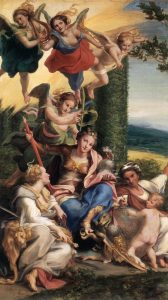Antonio Allegri (1489-1534) was born in Correggio, Italy, a small town. Little is known about Correggio’s early life or training. It is assumed that he was first educated artistically by his father’s brother, the painter Lorenzo Allegri. Correggio was known as a “shadowy, melancholic and introverted character.” He was enigmatic as he did not appear to have emerged from any major apprenticeship. Correggio visited the cities of northern Italy and studied the works of Leonardo’s pupils, learned about his treatment of light and shade. According to the Story of Art, “It was in this field that he worked out entirely new effects which greatly influenced later schools of painters”. Considered a master of chiaroscuro, Correggio created some of the most vigorous and sensuous 16th century works. He is thought of as the most “progressive” and mot daring innovator of the whole period. He made use of ‘dynamic composition, illusionistic perspective and dramatic foreshortening’ (wikipedia) in his work in a style much like what would be to come in the Baroque Era of the 17th century and the Rococo art of the 18th century. The way that Correggio painted the ceilings and cupolas of churches was copied for many centuries thereafter. He gave the worshipers looking up the illusion that the ceiling had opened and that they were looking straight into Heaven. His mastery of light effects enabled him to fill the ceilings with sunlit clouds between which the heavenly host seem to hover with their legs dangling downwards. Lots of people at the time objected to the fact that this may not look very ‘dignified’. Correggio had in fact little immediate influence in terms of apprenticed successors. However, his works are now considered to have been revolutionary and influential on later artists.
Notable works:





Works Cited:
https://en.wikipedia.org/wiki/Nativity_(Correggio)
https://en.wikipedia.org/wiki/Antonio_da_Correggio
The Story of Art, EH Gombrich
Coralie,
Well researched and good personal opinion and comments. Like that you see the link with Fouquet between southern and northern influences which certainly emerge in his work. Possibly the only comment I have is that the images could be a bit bigger… they are pretty small here.
Jeff